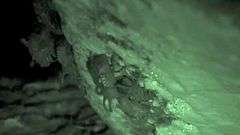Bolitotherus cornutus
| Forked fungus beetle | |
|---|---|
 | |
| A pair of Bolitotherus cornutus in copula, attacked by a second male. | |
 | |
| A scene from the video. The large male on the right attacks the smaller male on top of the female. | |
| Scientific classification | |
| Kingdom: | Animalia |
| Phylum: | Arthropoda |
| Class: | Insecta |
| Order: | Coleoptera |
| Family: | Tenebrionidae |
| Subfamily: | Tenebrioninae |
| Tribe: | Bolitophagini |
| Genus: | Bolitotherus |
| Species: | B. cornutus |
| Binomial name | |
| Bolitotherus cornutus Panzer, 1794 | |
Bolitotherus cornutus is a North American species of darkling beetle known as the forked fungus beetle. As a holometabolic insect, its life cycle includes four life stages: egg, larva, pupa, and adult. All life stages are associated with the fruiting bodies of a wood-decaying shelf fungus, commonly Ganoderma applanatum,[1] Ganoderma tsugae,[1] and Ganoderma lucidum.[2]
Description
Adults are brown, armored beetles, about 1 cm long, that are sexually dimorphic with respect to the presence of horns.[3] Females lack horns. Males use their two sets of horns, clypeal and thoracic, to compete for mates. Unlike many species of scarab beetles that exhibit male dimorphism for horns with major and minor morphs,[4][5][6] male B. cornutus possess a continuous range of horn and body sizes.[7][8] Adult beetles are active at night, but may be found during the day on the undersides of their host fungi.
Reproductive Behavior
Bolitotherus cornutus adults perform reproductive behaviors on the surfaces of fruiting bodies of their host fungus.[7] Mating pairs engage in a courtship ritual in which the male grips the female's elytra, with his thorax over the end of her abdomen. Courtship often lasts several hours, and is a necessary precursor to copulation. During a copulation attempt, the male reverses position on top of the female so that both individuals point the same direction and their abdomens are aligned. If the courtship is successful, the female opens her anal sternite and copulation takes place. Following copulation, the male remains on top, facing the same direction as the female, and mate-guards her. The male remains in this position for several hours, preventing other males from courting the female. Later, the female will deposit single eggs on the upper surface of a host fungus, then cover each egg with a distinctive dark brown oval of frass.[1] When the eggs hatch, the larvae burrow into and consume the fungus, in which they later pupate before emerging as adults.
Parasites
Some larvae die after attack by an uncharacterized parasitic fungus, or when parasitized by a braconid wasp, Eubadizon orchesiae, that makes a light yellow silken cocoon in the body of the larva.[1]
Gallery
-
A Bolitotherus cornutus larva.
-

A male Bolitotherus cornutus undergoing a grip strength measurement.
References
- 1 2 3 4 Liles, M.P. (1956). "A study of the life history of the forked fungus beetle, Bolitotherus cornutus" (PDF). Ohio J Sci. 56: 329–337.
- ↑ Heatwole, H.; Heatwole, A. (1 January 1968). "Movements, Host-Fungus Preferences, and Longevity of Bolitotherus cornutus (Coleoptera: Tenebrionidae)". Annals of the Entomological Society of America. 61 (1): 18–23. doi:10.1093/aesa/61.1.18.
- ↑
 This article incorporates text from a scholarly publication published under a copyright license that allows anyone to reuse, revise, remix and redistribute the materials in any form for any purpose:
This article incorporates text from a scholarly publication published under a copyright license that allows anyone to reuse, revise, remix and redistribute the materials in any form for any purpose:
Benowitz, K. M.; Brodie, E. D.; Formica, V. A. (2012). Proulx, Stephen R, ed. "Morphological Correlates of a Combat Performance Trait in the Forked Fungus Beetle, Bolitotherus cornutus". PLoS ONE. 7 (8): e42738. doi:10.1371/journal.pone.0042738. PMC 3419742 . PMID 22916153. Please check the source for the exact licensing terms.
. PMID 22916153. Please check the source for the exact licensing terms. - ↑ Lailvaux, S. P.; Hathway, J.; Pomfret, J.; Knell, R. J. (2005). "Horn size predicts physical performance in the beetle Euoniticellus intermedius (Coleoptera: Scarabaeidae)". Functional Ecology. 19 (4): 632. doi:10.1111/j.1365-2435.2005.01024.x.
- ↑ Emlen DJ (1996) Artificial selection on horn length body size allometry in the horned beetle Onthophagus acuminatus (Coleoptera: Scarabaeidae). Evolution 50: 1219–1230. doi:10.2307/2410662
- ↑ Emlen, D. J.; Corley Lavine, L.; Ewen-Campen, B. (2007). "Colloquium Papers: On the origin and evolutionary diversification of beetle horns". Proceedings of the National Academy of Sciences. 104: 8661. doi:10.1073/pnas.0701209104.
- 1 2 Conner JK (1988) Field measurements of natural and sexual selection in the fungus beetle, Bolitotherus cornutus. Evolution 42: 736–749. doi:10.2307/2408865.
- ↑ Formica, V. A.; McGlothlin, J. W.; Wood, C. W.; Augat, M. E.; Butterfield, R. E.; Barnard, M. E.; Brodie Iii, E. D. (2011). "Phenotypic Assortment Mediates the Effect of Social Selection in a Wild Beetle Population". Evolution. 65 (10): 2771–2781. doi:10.1111/j.1558-5646.2011.01340.x. PMID 21967420.
External links
| Wikispecies has information related to: Bolitotherus cornutus |
| Wikimedia Commons has media related to Bolitotherus cornutus. |